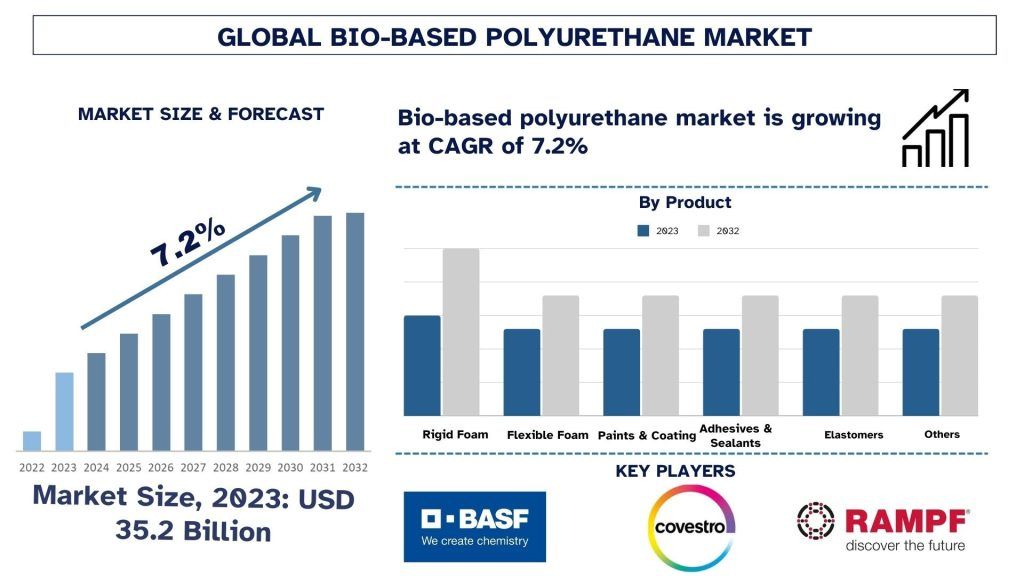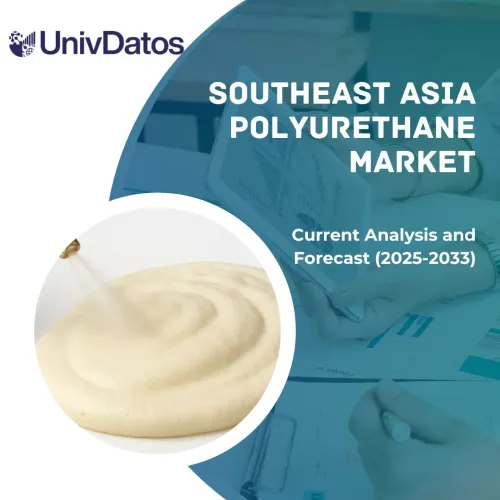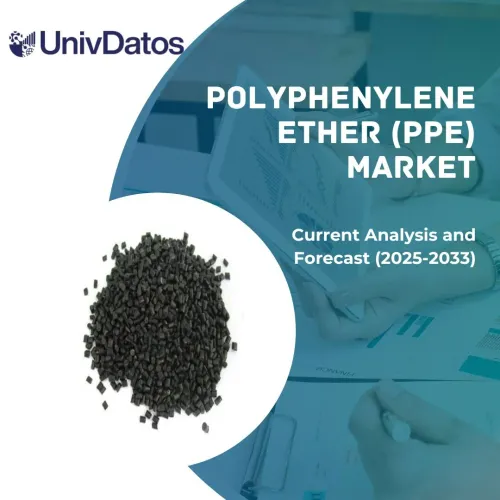- Home
- About Us
- Industry
- Services
- Reading
- Contact Us
Bio-Based Polyurethane Market: Current Analysis and Forecast (2024-2032)
Emphasis on Product (Flexible Foam, Rigid Foam, Paints & Coatings, Adhesives & Sealants, Elastomers, and Others); End-Use (Automotive, Building & Construction, Bedding & Furniture, Footwear, Electrical & Electronics, and Others); and Region and Country
Bio-Based Polyurethane Market Size & Forecast
The Bio-Based Polyurethane market was valued at approximately USD 35.2 Billion in 2023 and is expected to grow at a robust CAGR of around 7.2% during the forecast period (2024-2032). The market for bio-based polyurethane is on the rise due to bioplastics, environmental legislation, and demand for renewable raw materials.
Bio-Based Polyurethane Market Analysis
Polyurethane is used in many like flexible foam, rigid foam, coatings, adhesives, sealants, and elastomers in a wide range of industries including building & construction, automotive, and electrical & electronics to name a few. For instance, due to its excellent strength-to-weight ratio, insulation properties, durability, and versatility, it is widely used in building & construction applications. However, changing industry focus towards sustainable production and consumer inclination towards products that are produced using bio-based raw materials is gaining momentum. This has created a demand for bio-based polyurethane for the manufacturing of products like foams and coatings. Therefore, it is expected that with the growth in the construction industry, increasing adoption of green buildings, recovery in the automobile sector along with aim of replacing the fossil-based, non-biodegradable counterparts, the market of bio-based polyurethane would showcase robust growth.
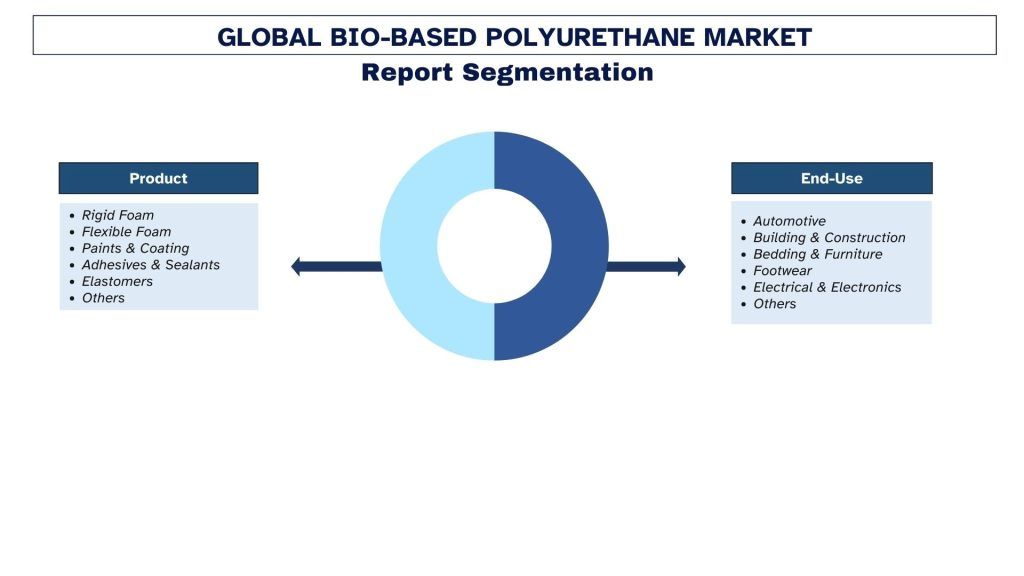
Bio-Based Polyurethane Market Trends
This section discusses the key market trends influencing the fungicide segments as identified by our research experts.
Flexible Foam Segment Transforming Industry
Based on product, the market is categorized into flexible foam, rigid foam, paints & coatings, adhesives & sealants, elastomers, and others. Among these, flexible foam held a prominent share in the market. Since it is light in weight, durable, supportive, and comfortable, thereby it is used as a cushion in a wide range of application areas like bedding, furniture, automotive interiors, carpet underlay, and packaging. Moreover, according to the American Chemistry Council, flexible foam accounts for about 30% of the entire North American polyurethane market.
Asia Pacific to hold a significant share of the market
Asia-Pacific held a considerable share in the global bio-based polyurethane market owing to the large and rapidly growing end-use industry, particularly in countries like China and India. For instance, according to Oxford Economics, between 2020-2030, India is expected to showcase the fastest growth rate of 9.8% in infrastructure construction, across the globe. Further, the shifting of manufacturing facilities from Western economies to the Asia-Pacific is increasing the consumption of bio-based polyurethane.
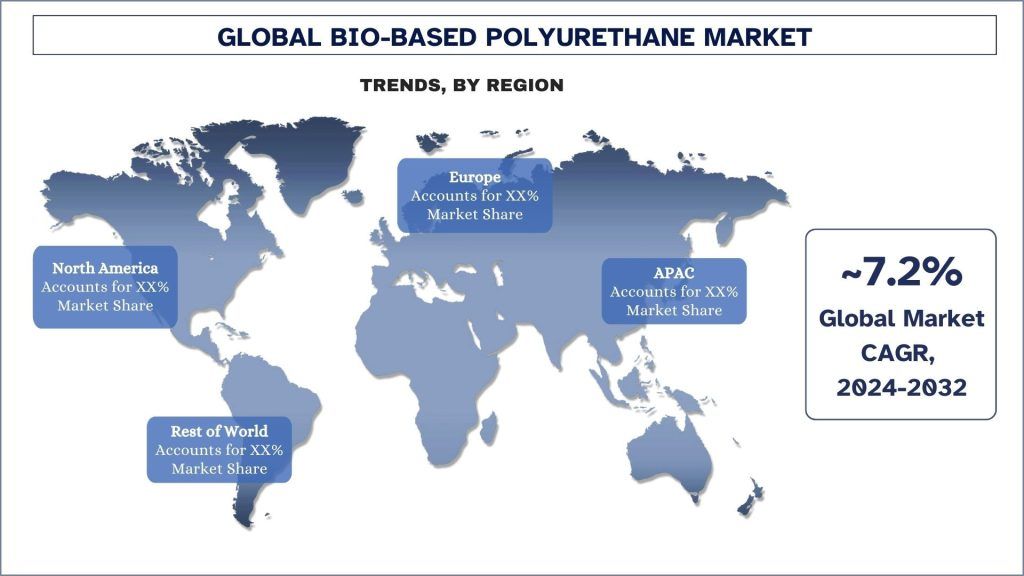
Bio-Based Polyurethane Industry Overview
Bio-based polyurethane is competitive, with several global and international market players. The key players are adopting different growth strategies to enhance their market presence, such as partnerships, agreements, collaborations, new product launches, geographical expansions, and mergers and acquisitions. Some of the major players operating in the market are BASF, RAMPF Holding GmbH & Co. KG, Covestro AG, Huntsmen International LLC, MCPU Polymer Engineering LLC, The Lubrizol Corporation, Stahl Holdings B.V., Arkema, Mitsui Chemicals, Inc, Miracll Chemicals Co., Ltd. Several M&As along with partnerships have been undertaken by these players to facilitate customers with hi-tech and innovative products/technologies.
Bio-Based Polyurethane Market Report Coverage
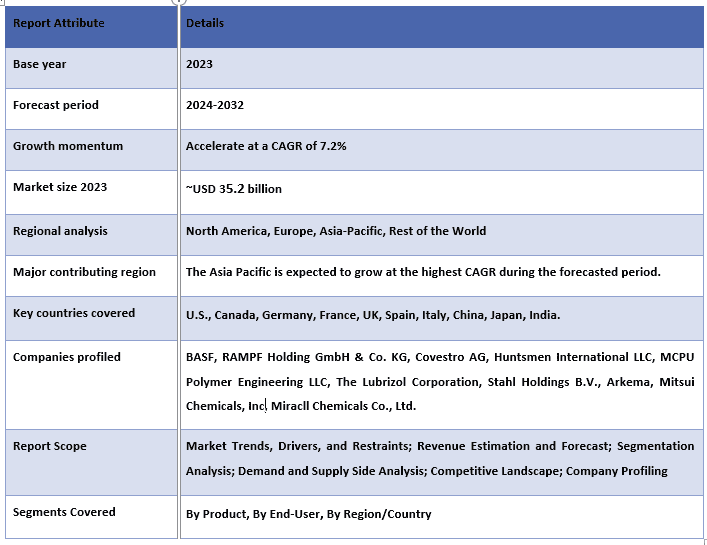
Reasons to buy this report:
- The study includes market sizing and forecasting analysis validated by authenticated key industry experts.
- The report presents a quick review of overall industry performance at one glance.
- The report covers an in-depth analysis of prominent industry peers with a primary focus on key business financials, product portfolios, expansion strategies, and recent developments.
- Detailed examination of drivers, restraints, key trends, and opportunities prevailing in the industry.
- The study comprehensively covers the market across different segments.
- Deep dive regional level analysis of the industry.
Customization Options:
Global Bio-Based Polyurethane can further be customized as per the requirement or any other market segment. Besides this, UMI understands that you may have your own business needs; hence, feel free to connect with us to get a report that completely suits your requirements.
Table of Content
Research Methodology for the Bio-Based Polyurethane Market Analysis (2022-2032)
Analyzing the historical market, estimating the current market, and forecasting the future market of the global Bio-Based Polyurethane market were the three major steps undertaken to create and analyze the adoption of Bio-Based Polyurethane in major regions globally. Exhaustive secondary research was conducted to collect the historical market numbers and estimate the current market size. Secondly, numerous findings and assumptions were taken into consideration to validate these insights. Moreover, exhaustive primary interviews were also conducted, with industry experts across the value chain of the global Bio-Based Polyurethane market. Post assumption and validation of market numbers through primary interviews, we employed a top-down/bottom-up approach to forecasting the complete market size. Thereafter, market breakdown and data triangulation methods were adopted to estimate and analyze the market size of segments and sub-segments of the industry. Detailed methodology is explained below:
Analysis of Historical Market Size
Step 1: In-Depth Study of Secondary Sources:
A detailed secondary study was conducted to obtain the historical market size of the Bio-Based Polyurethane market through company internal sources such as annual reports & financial statements, performance presentations, press releases, etc., and external sources including journals, news & articles, government publications, competitor publications, sector reports, third-party database, and other credible publications.
Step 2: Market Segmentation:
After obtaining the historical market size of Bio-Based Polyurethane, we conducted a detailed secondary analysis to gather historical market insights and share for different segments & sub-segments for major regions. Major segments are included in the report, such as product, end-use, and region. Further country-level analyses were conducted to evaluate the overall adoption of testing models in that region.
Step 3: Factor Analysis:
After acquiring the historical market size of different segments and sub-segments, we conducted a detailed factor analysis to estimate the current market size of the Bio-Based Polyurethane market. Further, we conducted factor analysis using dependent and independent variables such as product, end-use, and Specialty tape regions. A thorough analysis was conducted of demand and supply-side scenarios considering top partnerships, mergers and acquisitions, business expansion, and product launches in the Bio-Based Polyurethane market sector across the globe.
Current Market Size Estimate & Forecast
Current Market Sizing: Based on actionable insights from the above three steps, we arrived at the current market size, key players in the global Bio-Based Polyurethane market, and market shares of the segments. All the required percentage shares split and market breakdowns were determined using the above-mentioned secondary approach and were verified through primary interviews.
Estimation & Forecasting: For market estimation and forecast, weights were assigned to different factors including drivers & trends, restraints, and opportunities available for the stakeholders. After analyzing these factors, relevant forecasting techniques i.e., the top-down/bottom-up approach were applied to arrive at the market forecast for 2032 for different segments and sub-segments across the major markets globally. The research methodology adopted to estimate the market size encompasses:
The industry’s market size, in terms of revenue (USD) and the adoption rate of Bio-Based Polyurethane across the major markets domestically
All percentage shares, splits, and breakdowns of market segments and sub-segments
Key players in the global Bio-Based Polyurethane in terms of products offered. Also, the growth strategies adopted by these players to compete in the fast-growing market
Market Size and Share Validation
Primary Research: In-depth interviews were conducted with the Key Opinion Leaders (KOLs), including Top Level Executives (CXO/VPs, Sales Head, Marketing Head, Operational Head, Regional Head, Country Head, etc.) across major regions. Primary research findings were then summarized, and statistical analysis was performed to prove the stated hypothesis. Inputs from primary research were consolidated with secondary findings, hence turning information into actionable insights.
Split of Primary Participants in Different Regions
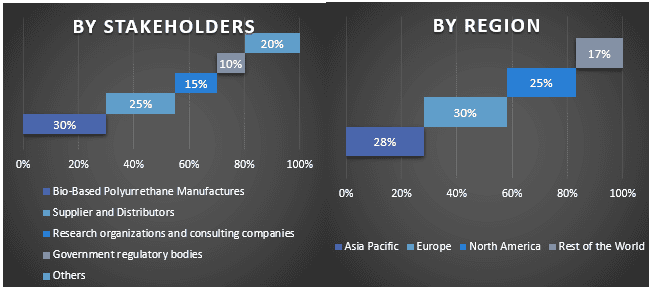
Market Engineering
The data triangulation technique was employed to complete the overall market estimation and to arrive at precise statistical numbers for each segment and sub-segment of the global Bio-Based Polyurethane. Data was split into several segments and sub-segments after studying various parameters and trends in the product, end-use, and regions of the global Bio-Based Polyurethane market.
The main objective of the Global Bio-Based Polyurethane Market Study
The current & future market trends of global Bio-Based Polyurethane were pinpointed in the study. Investors can gain strategic insights to base their discretion for investments on the qualitative and quantitative analysis performed in the study. Current and future market trends determined the overall attractiveness of the market at a regional level, providing a platform for the industrial participant to exploit the untapped market to benefit from a first-mover advantage. Other quantitative goals of the studies include:
- Analyze the current and forecast market size of the Bio-Based Polyurethane market in terms of value (USD). Also, analyze the current and forecast market size of different segments and sub-segments.
- Segments in the study include areas of product, end-use, and regions.
- Define and analyze the regulatory framework for the Bio-Based Polyurethane
- Analyze the value chain involved with the presence of various intermediaries, along with analyzing customer and competitor behaviors of the industry.
- Analyze the current and forecast market size of the Bio-Based Polyurethane market for the major regions.
- Major countries of regions studied in the report include Asia Pacific, Europe, North America, and the Rest of the World
- Company profiles of the Bio-Based Polyurethane market and the growth strategies adopted by the market players to sustain in the fast-growing market.
- Deep dive regional level analysis of the industry
Frequently Asked Questions FAQs
Q1: What is the global Fungicide's current size and growth potential?
Q2: What are the driving factors for the growth of global Bio-Based Polyurethane?
Q3: Which segment has the largest share of the global Bio-Based Polyurethane by product?
Q4: What are the emerging technologies and trends in global Bio-Based Polyurethane?
Q5: Which region will dominate global Bio-Based Polyurethane?
Related Reports
Customers who bought this item also bought

